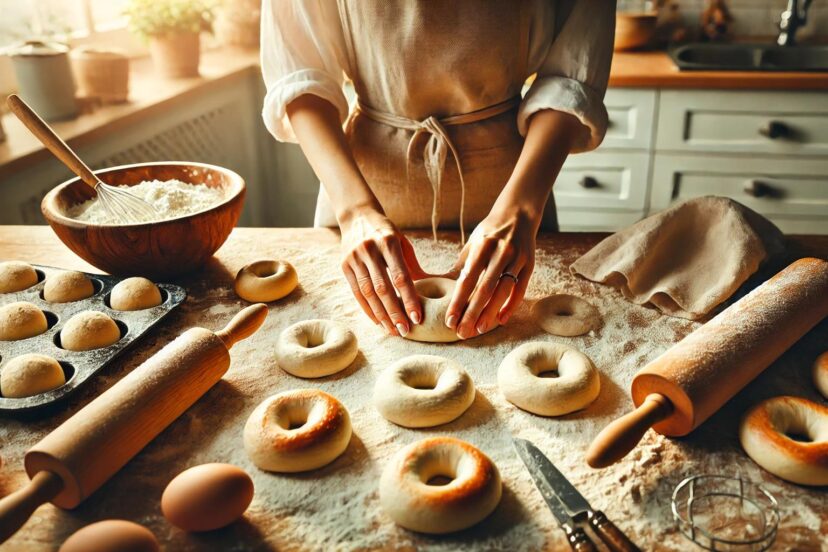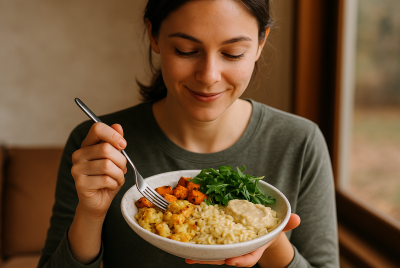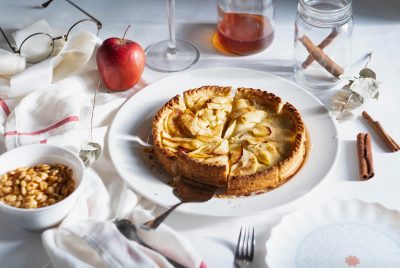Easy Gluten Free Bagel Recipe
We may earn a commission for purchases made using our links. Please see our disclosure to learn more.
Craving a delicious, fresh bagel, but stuck with gluten intolerance? Finding gluten-free options that taste just as good as the real thing can be frustrating. I know that for a fact! Most of the time, store-bought bagels are dense, bland, and not to mention, kinda expensive too. So, if that’s the case, then why not make your own? Here is a simple gluten free bagel recipe that you can make at home.
What Makes a Bagel Special?
People love bagels for a couple of reasons but one thing’s for sure, it’s a quick and yummy breakfast option. Bagels are boiled, baked, and boast a chewy texture that sets them apart from their fluffier bread cousins. The challenge for gluten-free bakers? Recreating that iconic texture without traditional wheat flour. But hey, don’t worry too much; with the right ingredients and a sprinkle of determination (and this gluten free bagel recipe), it’s absolutely achievable.
Why Go Gluten-Free?
Some people have gluten sensitivity and even celiac disease which makes them avoid foods with gluten. For others, it’s about feeling better in their own skin, with improved digestion and energy. Whatever your reason is, going gluten-free doesn’t mean sacrificing flavor. Gluten-free bagels are living proof that you can enjoy life’s simple pleasures without compromise. It’s can be as tasty and chewy as regular bagels!!!
The Challenge of Gluten-Free Baking
Baking without gluten can feel like trying to catch water in your hands—it takes a little finesse. Gluten gives bread its stretch and strength, so going without it requires creative substitutes like psyllium husk or xanthan gum. But with the right tricks, you’ll transform your dough into a pliable masterpiece.
Essential Ingredients for Gluten Free Bagel Recipe
Here’s the dream team for your bagel adventure:
- Gluten-free flour blend: A mix of rice, tapioca, and potato flours often works like magic.
- Yeast: This little powerhouse brings life and rise to your dough.
- Psyllium husk powder: Think of it as the glue that holds everything together.
- Salt and sugar: These bring out the flavor and balance the yeast.
- Warm water: A gentle touch ensures your yeast springs to action.
- Toppings: Sesame seeds, garlic flakes, or everything bagel seasoning are your finishing touches.
Each ingredient plays a vital role, so trust the process and embrace the magic.
Step 1: Activating Your Yeast
The yeast is your culinary alchemist. Mix it with warm water and sugar, then let it bubble and froth like a tiny celebration in your mixing bowl. This step is the key to ensuring your bagels rise like champs.
Step 2: Mixing the Dough
Combine your flour blend, psyllium husk, salt, and sugar in a mixing bowl. Slowly pour in the bubbly yeast mixture, stirring as you go. The dough will come together, sticky and thick—more batter than traditional dough, but that’s exactly what you want.
Step 3: Kneading Without Gluten
Even without gluten, your dough needs a little love. Gently knead it for a few minutes, adding a sprinkle of flour if it’s too sticky. This step ensures all your ingredients get cozy and the dough becomes more workable.
Step 4: Letting It Rest
Cover your dough with a damp towel and let it nap in a warm spot for an hour. During this time, the yeast works behind the scenes, infusing your dough with air and flavor. Patience is the secret ingredient here.
Step 5: Shaping Your Bagels
Divide your dough into even portions, roll each into a ball, and poke a hole in the center with your thumb. Gently stretch the hole to your desired size. Don’t worry about being flawless; part of the appeal is the rustic charm.
Step 6: Boiling for That Iconic Chew
Bring water to a gentle boil and add a tablespoon of honey or sugar. Drop your bagels in, letting them simmer for a minute on each side. This step is what gives bagels their signature chew and sheen.
Step 7: Adding Toppings
While they’re still damp from boiling, sprinkle on your chosen toppings. Press them gently so they cling tightly during baking.
Step 8: Baking to Perfection
Preheat your oven to 425°F (220°C). Line a baking sheet with parchment paper, arrange your bagels with care, and bake for 20-25 minutes. The golden aroma will be your signal—they’re ready to enjoy!

Must-Have Products for Making Gluten-Free Bagels
To ensure your gluten-free bagels turn out perfectly, having the right tools and ingredients is essential. Here’s a curated list of must-have products to make your bagel-making experience seamless:
Gluten-Free Ingredients
- Bob’s Red Mill Gluten-Free 1-to-1 Baking Flour – A reliable, versatile flour blend with xanthan gum included.
- Anthony’s Psyllium Husk Powder – A top-notch binder for perfect texture and elasticity.
- Red Star Active Dry Yeast – Consistently reliable yeast for flawless dough rising.
Essential Baking Tools
- Mixing Bowls Set – Durable, non-slip bowls for easy dough preparation.
- KitchenAid Stand Mixer – Optional but helpful for effortless dough mixing and kneading.
Toppings and Flavor Enhancers
- Everything But the Bagel Seasoning – A quick way to add that iconic everything bagel flavor.
- McCormick Sesame Seeds – A classic topping for added crunch and nutty flavor.
These products will simplify your gluten-free bagel-making journey and ensure professional-quality results right from your kitchen!
Why Psyllium Husk Is a Game-Changer
Psyllium husk is like the quiet hero of gluten-free baking. It keeps the dough together, traps moisture, and creates that tender-but-chewy texture you’re after. Without it, your bagels might end up dry or crumbly—so don’t skip this powerhouse.
Scientific Insights into Gluten-Free Baking
Gluten-free baking presents unique challenges due to the absence of gluten, which provides structure and elasticity in traditional dough. A comprehensive review on gluten-free bread and bakery products technology highlights how hydrocolloids and enzymes can effectively improve dough stability and bread quality. Similarly, a systematic review of gluten-free dough and bread explores innovative strategies like using alternative proteins, hydrocolloids, and emulsifiers to replicate gluten’s viscoelastic properties. These insights are crucial for enhancing gluten-free bagel recipes and achieving bakery-quality results at home.
Avoiding Common Gluten-Free Mistakes
Gluten-free baking can have its hiccups, but they’re easy to sidestep. Double-check your flour blend, always boil your bagels, and don’t skimp on resting time. These small steps make a world of difference.
Customizing Your Bagels
Want something sweet? Toss in raisins and cinnamon. Feeling bold? Try jalapeños and cheddar. The possibilities are endless—let your imagination guide you.
Storing Gluten-Free Bagels
If there are leftovers (a big “if”), store them in an airtight container for up to three days or freeze them for longer freshness. A quick toast will revive their delightful texture.
Serving Suggestions
Top with cream cheese and smoked salmon for a classic treat or almond butter and honey for a sweet twist. They’re versatile, so have fun experimenting!
The Joy of Baking Together
Baking is as much about connection as it is about creating. Gather your family or friends, share laughs, and enjoy the journey of making something delicious together.
Summing It Up
Homemade gluten-free bagels are more than a recipe—they’re an adventure. With a little patience and love, you’ll create bagels that are chewy, flavorful, and entirely satisfying. So, roll up your sleeves, follow this gluten free bagel recipe and let’s bagel!
FAQs
1. Can I make these bagels vegan?
Absolutely! Just use a vegan-friendly gluten-free flour blend and skip any egg washes.
2. Is it possible to use almond flour?
Not by itself. Almond flour lacks the structure needed, so pair it with other gluten-free flours for balance.
3. Should I use psyllium husk?
While highly recommended for the best texture, you can substitute flaxseed meal if necessary, though the results may vary slightly.
4. Why do I need to boil bagels?
Boiling is the magic step that gives bagels their glossy crust and signature chew. Skipping this step will leave you with round bread rolls instead of bagels.
5. How can I prepare the spice for everything bagel?
Mix up some salt, sesame seeds, dried onion, garlic flakes, and a sprinkle of poppy seeds—boom, instant flavor bomb! Sprinkle liberally, and enjoy the flavor explosion.




